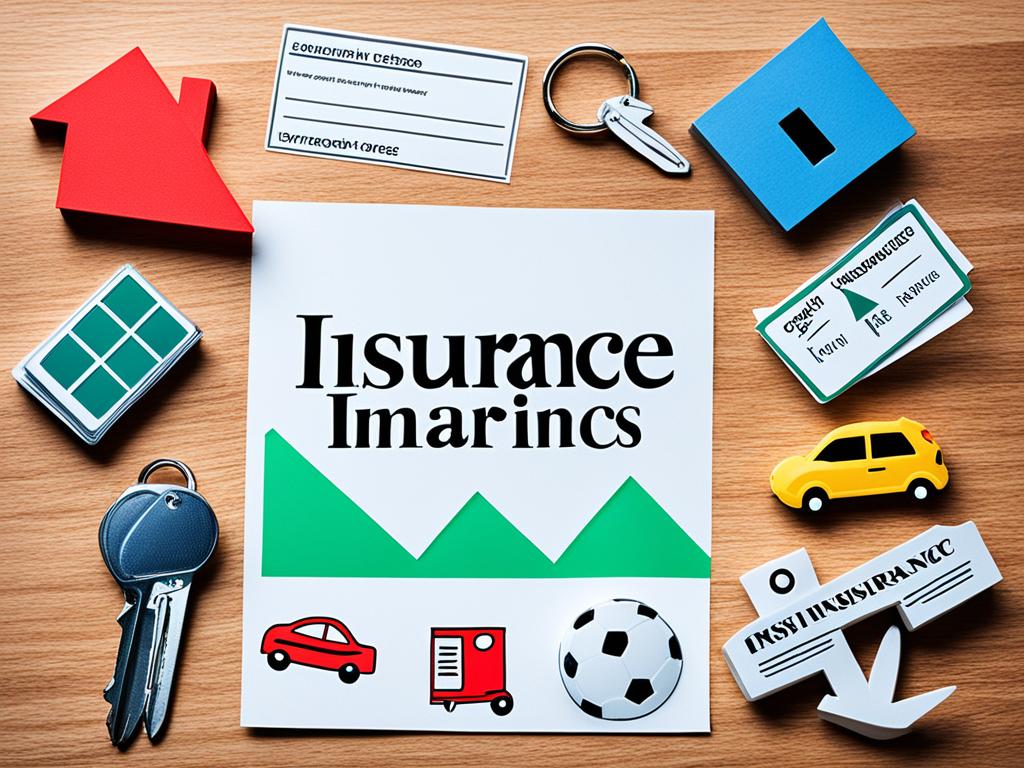
Understanding Different Types of Insurance Policies
Understanding the different types of insurance options is key in today’s changing financial world. This article will cover life, health, auto, homeowners, and more. It aims to help you make smart choices to protect your finances.

This guide covers how to protect your loved ones and your health. Additionally, it helps you understand auto and home insurance. Furthermore, you’ll learn how to make choices that fit your life and needs.
It also looks at disability insurance and umbrella policies. By the end, you’ll know how different insurance types work together. This can help create a strong financial safety net.
Types of Insurance Policies: Exploring the Essentials
Understanding the different types of insurance policies is key to protecting your financial well-being. Life insurance and health insurance are two main types you should know about. Let’s look at what these essential insurance products cover.
Life Insurance: Protecting Your Loved Ones
Life insurance helps your loved ones financially if you pass away. Specifically, it covers funeral costs, pays off debts, and secures their future. Moreover, this insurance gives you peace of mind, knowing your family is protected financially, even if you’re not there.
Health Insurance: Safeguarding Your Well-being
Health insurance is a safety net against high medical costs. For instance, it covers everything from check-ups to emergencies. Consequently, with the right health insurance, you won’t worry about medical bills, allowing you to focus on getting better.
Knowing about life and health insurance helps you make smart choices. It ensures you and your loved ones are protected, no matter what.

Types of Insurance: Auto Insurance
Auto insurance is a must-have for everyone. In fact, it’s the law in most places and keeps you and your car safe in accidents or other road incidents. Therefore, knowing about the different types of coverage helps you pick the right one to protect your money.
Liability coverage is key. Specifically, it covers you if you cause an accident and pay for the other person’s damages and injuries. In addition, collision coverage pays for fixing or replacing your car if it hits another car or object.
Don’t forget about comprehensive auto insurance. It covers damage from theft, vandalism, or natural disasters. This coverage keeps your car safe from unexpected events.
Auto insurance also includes personal injury protection (PIP) and uninsured/underinsured motorist coverage. PIP covers medical bills for you and your passengers. Uninsured/underinsured motorist coverage helps if you hit someone without insurance.
| Coverage Type | What It Covers |
|---|---|
| Liability | Damages and injuries to the other party in an accident |
| Collision | Repair or replacement of your vehicle after a collision |
| Comprehensive | Damages to your vehicle not caused by a collision, such as theft or natural disasters |
| Personal Injury Protection (PIP) | Medical expenses for you and your passengers |
| Uninsured/Underinsured Motorist | Protection if you are involved in an accident with a driver who has insufficient insurance |
Understanding auto insurance coverage lets you choose the right policy. This way, you can drive with peace of mind, knowing you and your car are protected.

Homeowners Insurance: Sheltering Your Greatest Asset
Homeowners insurance is key to protecting your biggest investment—your home. Not only does it cover your property, but it also offers financial help if something unexpected happens. For instance, this includes liability coverage and extra living expenses, ensuring you’re financially safe.
Liability Coverage: Protecting Your Finances
Liability coverage is a big part of homeowners insurance. Specifically, it keeps you safe if someone gets hurt at your place or if you accidentally damage someone else’s property. Consequently, with this coverage, you won’t have to worry about your money if you face a big lawsuit or have to pay a settlement.
Additional Living Expenses: A Safety Net in Uncertain Times
Homeowners insurance also covers extra living expenses (ALE) if your home can’t be lived in because of a covered event like a fire or natural disaster. ALE helps pay for temporary housing, food, and other important costs while your home is fixed or rebuilt. This can be a big help during tough times.
| Coverage Type | Description |
|---|---|
| Liability Coverage | Protects you from legal liability if someone is injured on your property or you accidentally cause damage to someone else’s property. |
| Additional Living Expenses (ALE) | Provides coverage for temporary housing, meals, and other essential expenses if your home becomes uninhabitable due to a covered event. |

Choosing comprehensive homeowners insurance is smart to protect your most valuable asset – your home. By knowing about different coverages like liability insurance and extra living expenses, you can keep your family and finances safe from unexpected events.
Types of Insurance: Disability Insurance
Protecting your financial well-being is key. Disability insurance is a vital part of that. It helps if you can’t work due to illness or injury. Knowing the difference between short-term disability insurance and long-term disability insurance helps you choose the right one for you.
Types of Insurance: Short-Term Disability Insurance
Short-term disability insurance gives you temporary income support, usually for 3 to 6 months. It covers part of your income if you’re out sick or hurt. This is great for filling the gap before long-term benefits start.
Types of Insurance: Long-Term Disability Insurance
Long-term disability insurance offers financial support for a long time if you’re disabled. It starts after short-term coverage ends and can last until you retire. This kind of disability insurance is key to keeping your finances stable and your lifestyle intact.
Choosing between short-term or long-term disability insurance is important. It’s a smart way to protect your income and stay financially strong when health issues hit.

Umbrella Insurance: An Extra Layer of Protection
In the world of insurance, umbrella insurance is often overlooked. Yet, it offers an extra layer of protection beyond what your home and auto policies provide. It can be a lifesaver for protecting your assets and financial well-being.
Picture this: A guest falls on your property and sues, and the costs go beyond your insurance limits. Or, you’re in a car accident that leads to huge medical bills and legal claims. In these cases, umbrella insurance can help protect your savings, investments, or even your home from being taken to cover the costs.
Umbrella insurance is great because it offers a higher liability coverage limit, usually between $1 million and $5 million or more. This is especially useful for people with a lot of assets or those who take on more risks, like having a pool or running a business from home.
Also, umbrella insurance covers many liability claims, including personal injury, property damage, and legal defense costs. This broad coverage can offer you peace of mind and financial security if something unexpected happens.

Thinking about getting umbrella insurance? Look at your current insurance, your wealth, and the risks you might face. By carefully considering these factors, you can make a smart choice that protects your financial future.
Long-Term Care Insurance: Preparing for the Future
As we age, the need for extended medical care grows. Consequently, long-term care insurance can be a key support. Specifically, it covers costs for in-home care, assisted living, or nursing homes. Therefore, this insurance helps protect your savings and ensures you can live well, even with ongoing health issues.
Long-term care insurance offers peace of mind. By planning ahead, you won’t have to use your life savings for care. Moreover, it ensures that your family won’t have to bear the cost of your care.
It doesn’t matter if you’re in your 50s, 60s, or older; it’s smart to look into long-term care insurance now. Additionally, by learning about different policies, you can choose the right one for you. Ultimately, getting this insurance is a smart move to protect your future and your assets.
FAQ
What is the purpose of different types of insurance policies?
Insurance policies protect you from various risks. They cover life, health, auto, homeowners, disability, liability, and long-term care. Each policy is made for specific needs to keep your assets safe.
What is the difference between life insurance and health insurance?
Life insurance helps your loved ones after you pass away. Health insurance pays for medical care and treatments to keep you healthy.
What does auto insurance typically cover?
Auto insurance covers you in case of an accident. It helps fix or replace your car and covers non-collision incidents like theft or natural disasters.
What is the purpose of homeowners insurance?
Homeowners insurance protects your home and stuff from damage or loss. It also covers you if someone gets hurt on your property.
What is the difference between short-term and long-term disability insurance?
Short-term disability insurance gives you income if you can’t work for a few months due to illness or injury. Long-term disability insurance keeps paying you until you can work again or until you retire.
What is umbrella insurance, and how does it provide additional protection?
Umbrella insurance adds more protection on top of your home and auto policies. It covers big lawsuits or claims that go over your main insurance limits.
What is the purpose of long-term care insurance?
Long-term care insurance pays for extended medical care like home help, assisted living, or nursing homes. It saves your savings and assets if you need long-term care.



Understanding different types of insurance is very good and helps one to know the one to choose.